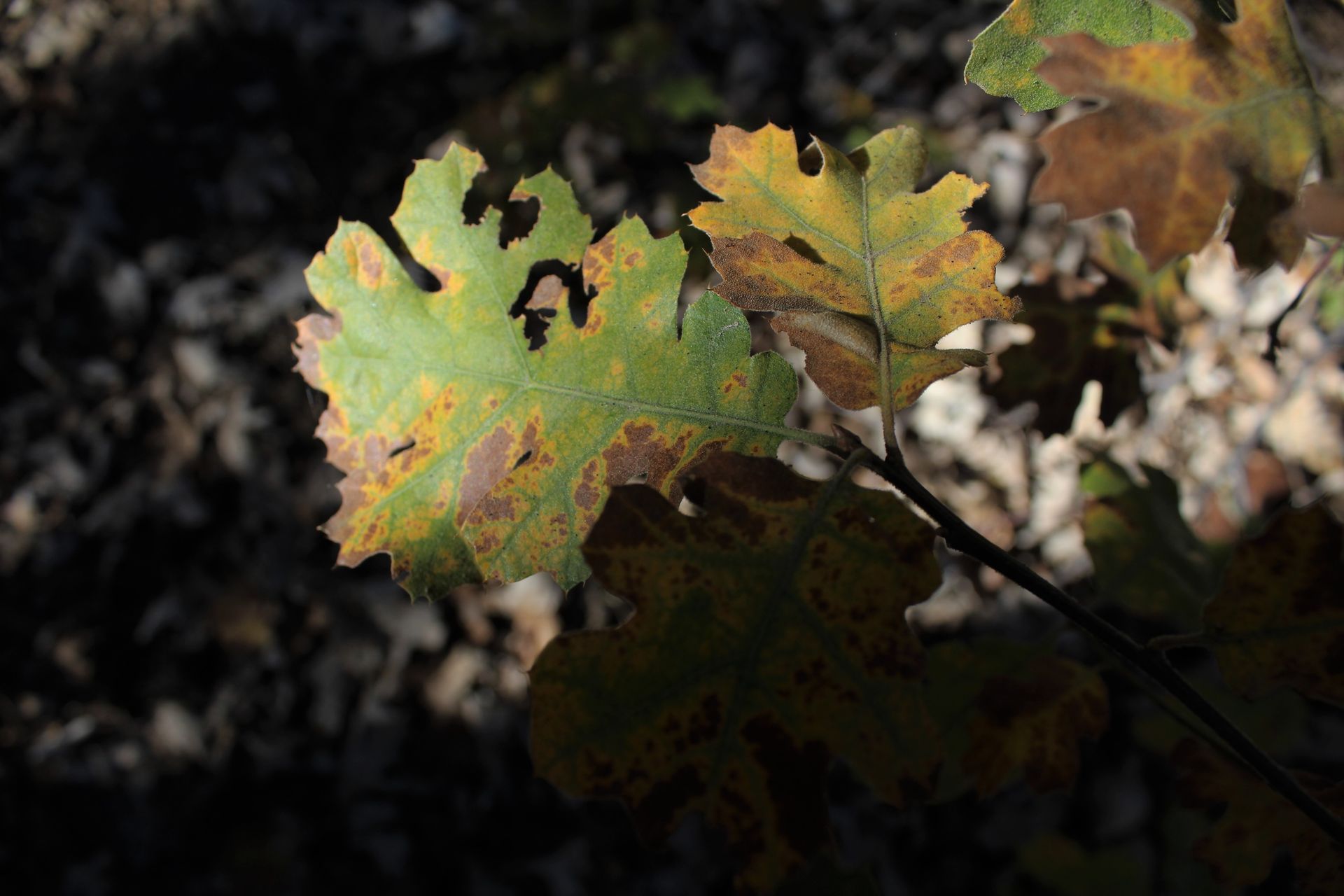Oak Wilt Disease And Treatment

Oak trees are susceptible to many diseases, including oak leaf blister, powdery mildew, bacterial leaf scorch, anthracnose, armillaria root rot, and oak wilt. These diseases affect different species of oak trees.
While most of these are fungal diseases, some may be caused by bacteria, viruses, or nematodes. The severity and symptoms of these diseases depend on their causative agents.
Fungal agents, such as those causing oak wilt, belong to the Ceratocystis genus. Oak wilt is a serious fungal disease that affects Spanish, blackjack, and Shumard oaks.
The guide goes into detail about oak wilt disease and treatment. We also explain the symptoms of oak wilt diseases for early identification.
Table of Contents
What Is Oak Wilt?
Oak wilt is a fungal disease caused by the fungus Ceratocystis fagacearum. The fungus grows in the sapwood of oak trees, blocking the xylem vessels and preventing water from flowing from the roots to the leaves. This disrupts photosynthesis, leading to wilting and leaf drop.
Oak wilt kills thousands of trees every year in urban areas and forests. The disease is most pronounced in red oaks but also affects other species. It can attack and kill black, northern pine, and northern red oaks too.
Once the symptoms of oak wilt start appearing on a tree, the infected tree loses its leaves. In most cases, the infected trees die in a month.
Did You Know? Oak wilt was identified in 1944. Experts believe that the oak wilt fungus is from the Eastern United States. But they weren't able to identify or isolate the fungus until the 1980s.
However, this doesn't hold true for some species of white oaks. Swamp white oaks and bur oaks are moderately resistant to oak wilt. Infected trees can live for a few years with the symptoms before dying. Some white oaks may survive oak wilt, while others experience slower disease progression.
Dead oak trees provide a suitable habitat for wildlife. Unlike birch, red maple, and aspen trees, which decompose quickly, oak decays slowly. So, the dead tree provides shelter to insects and other wildlife for years to come.
Grosbeaks, cardinals, rabbits, grouse, cuckoos, and deer can make their homes in dead oaks. When an oak dies due to oak wilt, its bark also falls off. The fallen park provides a habitat for brown creepers.
Dead oaks also provide nutrition. The insects that live in the dead tree's bark and wood provide food for birds.
Disease Cycle
Oak wilt season ranges from February to July. Oak wilt fungal mats form in early summer, and the nitidulid beetles are also the most active during this time.
The oak wilt fungus moves from infected trees to healthy trees through vectors or roots. Here's how.
Local Spread
The most common way oak wilt spreads is through the local spread. It's a process in which the fungus enters healthy trees through a connected root system.
The roots of a tree in a red oak group graft to the roots of other trees in the same group. These root grafts form an underground network of roots.
When fungus attacks one tree, the whole red or white oak group gets infected. As the fungus travels from one tree to another, it forms an infection center.
The infection center can extend up to 100 feet from the infected tree. How far the infection spreads also depends on the type of soil.
Sandy soils facilitate the formation of a root system, increasing roof grafting. Similarly, some oak species, such as Texas live oaks and Northern pin oaks grow in large groups.
These groups often share the same clonal root system. So, a diseased tree can kill tens of healthy trees with it.
Root grafts mainly only occur between oaks of the same species. But some exceptions exist. For example, roof grafts may form between red oaks and Texas live oaks.
Overland Spread
Insects can also spread oak wilt fungus to healthy trees, forming new infection centers. If the moisture conditions and temperature are right, spore-producing masses of fungal bodies form on deal oak trees.
These masses are called pressure pads, fungal mats, or spore pads. The mats touch the infected sapwood and the tree's bark. When they mature, they produce structures that put pressure on the bark.
The bark splits due to this pressure, creating a route for insects to enter the tree. Oak wilt mats produce a fruity odor that attracts nitidulid beetles. These beetles enter the tree through the spore mats.
When they leave the mats, they carry spores on their bodies to nearby trees.
What Causes Oak Wilt?
Ceratocystis fagacearum, now known as Bretziella fagacearum, causes oak wilt disease. The fungus is known to be host-specific, which means it only affects oak trees and other members of the Fagaceae family.
Symptoms
The symptoms of oak wilt disease differ in different oak species.
Red Oaks
The early signs of oak wilt in red oaks are wilting and rapid leaf discolouration. Initially, the upper part of the tree starts losing color in early July.
After the color shift comes the leaf wilting. The leaves in the crown start to wilt first, and the disease progresses downward. Infected trees defoliate (lose leaves) in a matter of weeks.
The fallen leaves are green at the base and brown at the margins and tips. Other healthy trees in the area may also be killed if they fall into the infection center.
White Oaks
The same symptoms appear in white oaks. But they progress slowly, affecting one branch at once. Infected white oaks also have brown streaking in their growth rings.
Texas Live Oaks
Texas live oaks experience the same symptoms but can live for up to six months after the infection. Leaves develop chlorotic (yellow) veins that turn brown over time. The symptom is called veinal necrosis.
Leaves that undergo veinal necrosis fall from the tree. The crown thins before the base, and eventually, the whole tree dies.
Texas live oaks may survive oak wilt in some conditions. The trees only experience crown loss in these cases.
Did You Know? Recent evidence shows that oak wilt entered North America at the beginning of the 1900s. But there have been no accounts of this fungus in any other country in the world. So, nothing much is known about its origin.
How To Treat and Prevent Oak Wilt Disease
Before you learn about oak wilt treatment, it's important to know how to diagnose the disease. The signs of oak wilt are not exclusive to the disease.
That's why oak wilt is often confused with other diseases. Some include two-lined chestnut borer, bur oak blight, and anthracnose.
If you suspect an oak tree in an urban area may have oak wilt diseases, contact your local urban forestry consultant. Or, you can send a sample of the tree bark to the University of Wisconsin-Madison Plant Disease Diagnostics Clinic. They will check the sample for oak wilt and send you the results.
You should contact your regional forest health specialist or forester for forest trees. If oak wilt infection is confirmed, the next step is treatment.
Treatment
Since treatment is not always an option, oak wilt management is better. Here are some strategies that prevent the spread of oak wilt infection.
Isolate Diseased Trees
As mentioned, oak wilt forms infection centers and kills multiple trees simultaneously. You can manage this by isolating the diseased trees from healthy oaks. Here are some ways to do this:
- Vibratory Plow Lines: A vibratory plow is used to create a barrier in the soil. It prevents the fungi from spreading through root grafts. The vibratory plow has a mechanical shaker unit connected to a blade. Use a 5-foot blade to disrupt the root system. Although some oak tree species might have deeper roots, plowing to five feet disrupts most grafts.
- Chain Trencher: A chain trencher or ripper bar may be needed in areas with rocky soils. The trencher forms barrier lines that disrupt the root grafts. Start with primary barrier lines to protect trees closest to the infected oak. You can then add secondary lines to save other trees farther away.
- Stump Extraction: If trenching or plowing is not possible, stump extraction will be most effective. In this process, you have to cut all trees in the infection center. Then, you use an excavator to pull the stumps of these trees from the ground to break the root systems.
Note that stump extraction works best for smaller infection centers. You can remove the tree stumps before the fungus spreads further into the root system.
Use Chemical Fungicides.
If you're dealing with high-value oak trees that you cannot afford to damage, use chemical methods for oak wilt treatment instead. The application of propiconazole is the most effective chemical method.
Do note that propiconazole does not prevent the spread of oak wilt through roots. So, it's not a substitute for cutting root connections. It can only delay the symptoms of oak wilt in healthy trees for two years if they have not been infected yet.
Do not apply propiconazole to red oaks showing symptoms of oak wilt. It's best to hire an arborist rather than apply a fungicide yourself.
Besides propiconazole, some biocidal chemicals can also disrupt roof connections. But they are quite dangerous and complex to worth with.
They are also used in combination with trenching and blowing. While the trencher forms holes in the soil, the arborist pours the chemical into these holes.
The chemical diffuses into the soil. It kills the roots in that area quickly. But these chemicals may only work on uniformly textured soils.
Plus, they are restricted-use pesticides. So, only a licensed professional can apply them.
Prevention
The spread of oak wilt disease can be hard to manage. That makes prevention the better option for protecting oak trees. Here are some strategies.
- Avoid wounding oak trees during the early summer and spring seasons. It will help prevent the spread of oak wilt fungal through sap-feeding beetles.
- If pruning is necessary, treat the wound immediately. Use a wound sealer or water-based sealer to cover the wound.
- Dispose of dead oaks properly. Otherwise, fungal mats will develop on these trees. The spores from these mats will then affect surrounding trees.
- If the diseased trees are on your property, debark their trunks. You can also cut logs into the lengths of firewood and keep them in stacks to dry.
- Do not move firewood or oak logs from infected logs in oak wilt season.
- If you haven't removed the cut-up logs from your property before the high-risk season, cover them until the right time for disposal arrives. A 4 to 6-inch clear plastic tarp will help keep beetles away from the spore mats.
- Make sure the tarp is thick enough to stay put against insect punctures.
- Debark or burn the infected logs before April. The bark or chips of the infected oaks do not spread the fungus. So, you can leave them on site.
Sweet New Earth's Final Word
Thanks for stopping by! Tree diseases are an annoying part of raising trees that we as gardeners need to get past in order to raise them to be healthy and beautiful trees.
FAQs

Christina Hernandez
Christina has done most of her research on environmental science but recently has changed her focus towards sustainable forestry. She has a passion for the outdoors and wants to spread that passion to the world.
Join our community!
Join to receive guides, insights, and the latest gardening deals!
